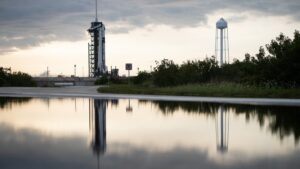NASA announced early April 21 that the launch of the SpaceX Falcon 9 carrying the Crew Dragon spacecraft had been rescheduled for April 23 at 5:49 a.m. Eastern. A launch at that time would allow the spacecraft to dock with the International Space Station at about 5:10 a.m. Eastern April 24.
While weather conditions are favorable at the launch site here for an April 22 launch, agency officials said their decision was based on forecasts of high winds and high waves at locations in the Atlantic where the spacecraft would splash down in the event of an abort during launch.
“Although the weather is probably going to look great here at the launch site, we’re worried about those downrange winds and wave heights in case of an abort,” Bob Cabana, director of the Kennedy Space Center, said in remarks at a media event here shortly after the agency announced the delay.
NASA warned at a briefing April 20 of the risk of a delay because of abort conditions, while forecasting good weather at KSC. Forecasts call for a 90% chance of acceptable weather for the April 23 launch opportunity.
NASA and the U.S. Space Force’s 45th Weather Squadron, which is responsible for launch forecasts at KSC and Cape Canaveral Space Force Station, provide detailed weather forecasts for launches. However, they provide far less information about abort weather conditions. For example, while noting high winds and wave heights, NASA didn’t elaborate on the specific conditions in the abort region, which stretches off the coast from Florida to Newfoundland, with another abort location across the Atlantic near Shannon, Ireland.
That abort weather introduces a complication in launch planning not seen since the end of the shuttle program, whose launches required good weather at selected airports in Europe and Africa that served as transatlantic abort locations. “Unlike a robotic mission, where we really need to just focus on weather here at the launch site, for a crewed mission we need to look downrange and make sure weather is good for a potential launch escape and recovery of the crew,” said Steve Jurczyk, NASA acting administrator, at the KSC media event.
“Weather looks better on Friday” April 23, he added.
Jurczyk added that the one-day delay in the arrival of the Crew-2 mission won’t affect the departure of the Crew-1 mission currently at the station. That Crew Dragon spacecraft will undock from the ISS at 7:05 a.m. April 28 and splash down in the Atlantic Ocean off the Florida coast at 12:40 p.m. Eastern that day.
Should the Crew-2 mission be delayed again, the next launch opportunity will be April 26. Forecasts for launch weather are a little less favorable, with a 70% chance of acceptable weather on April 26 and 27.



